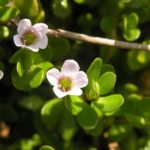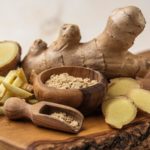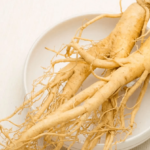
Megan Rodden
(BCS, DipNat, MedHerb, NMHNZ)
Jump to:
Menopause is a natural process experienced by all women when they no longer have a menstrual period.
Although there are many symptoms that can be caused by these changes there are natural remedies that can be used to support the body and may bring relief. Today we discuss the studies and research behind:
- Yoga
- Acupuncture
- Black cohosh
- Red clover
- Shatavari
and their positive effects on helping and managing menopause symptoms.
Understanding Menopause
The physiological process of the transition to menopause is complex and involves a number of different hormone changes. It also involves the natural reduction of eggs made by the ovaries.[1]
These changes occur in the reproductive system, but impact other systems in the body, like the cardiovascular system. This leads to the wide variety of symptoms experienced and it is why your general health and wellbeing can play a part in the symptoms you experience during the transition to menopause.
The age of onset of symptoms and symptom severity has been linked to a number of factors including genetics, socio-cultural beliefs and lifestyle factors, like diet and exercise.[2]
RELATED — Menopause: Guide to Signs and Symptoms
While some women transition through menopause with relative ease, others experience a range of symptoms including:
- hot flashes/flushes
- night sweats
- mood swings
- disrupted sleep
Understanding these changes and their impact is important for women to navigate this life stage.
Diet and exercise may affect the severity and onset of menopausal symptoms
This is why we will be discussing a natural approach that aims to support the body’s hormonal balance and minimise discomfort during this transformative stage of life.
Yoga
Yoga may offer a number of benefits for women going through menopause due to the positive impact on mental health and coping with stress. Yoga is a holistic, mind and body practice that involves movement and breathwork.
How it works
Yoga has been shown to reduce the impact of stress by increasing relaxation and reducing anxiety.[3] During menopause women often report experiencing anxiety and reduced capacity to cope with stress.

Research
Two systematic reviews of studies into yoga for menopause found that it was effective for managing short-term psychological symptoms, such as mood balance and anxiety, and evidence supports yoga for reducing menopause-related vasomotor symptoms.[4,5]
Yoga can help lower stress levels
One randomised control study also showed a significant (P < 0.001) reduction in hot flushes, night sweats and sleep disturbance in perimenopausal women, who practised yoga for one hour per day, for 8 weeks.[6] The yoga practice involved sun salutations as well as cycle meditation.
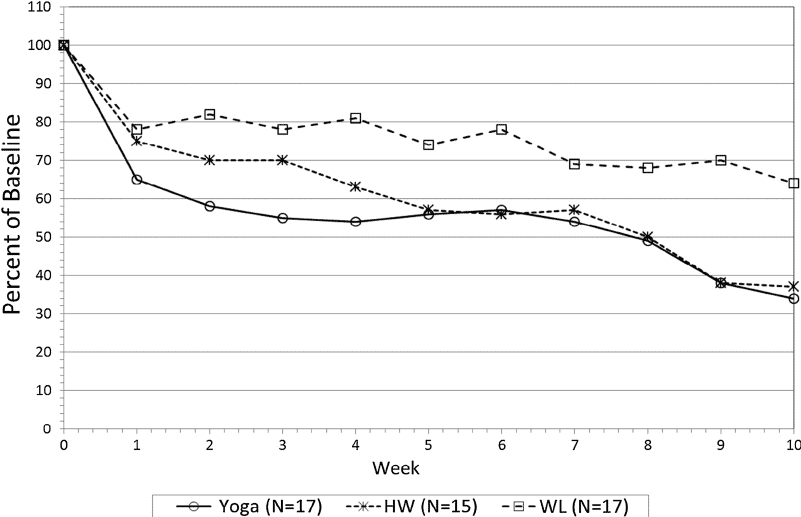
Source: Avis, N. Pilot study of integral yoga for menopausal hot flashes. The North American Menopause Society. 2014
Acupuncture
Acupuncture is an ancient Chinese medical practice that involves the insertion of thin needles into specific points on the body. The needles are placed at targeted points along energy pathways called meridians, in order to create balance or flow.
Acupuncture is known for its ability to provide relief from chronic conditions and is often used to support general wellbeing.
How it works
While its precise mechanisms are not entirely understood, studies propose that acupuncture may influence the central nervous system, modulate neurotransmitters, and regulate hormonal levels.
Research
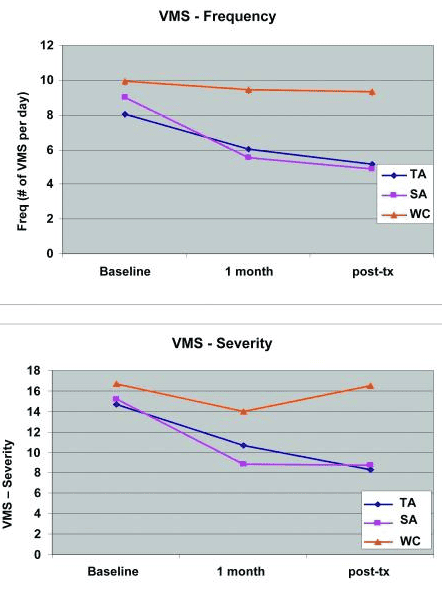
Source: Painovich, J. A Pilot Randomized, Single Blind, Placebo-Controlled Trial of Traditional Acupuncture for Vasomotor Symptoms and Mechanistic Pathways of Menopause. 2012.
A meta-analysis reviewed 12 high quality studies and found that acupuncture significantly reduced the frequency and severity of hot flashes compared to sham acupuncture or no treatment.
These studies also show that acupuncture improves other menopause-related symptoms, and quality of life in women experiencing natural menopause.[7]
Beyond symptom management, acupuncture embodies a holistic approach to wellness. Traditional Chinese Medicine views menopause as a rebalancing of the body’s energy.
Acupuncturists tailor treatments to address individual needs, promoting overall wellbeing.
Black Cohosh
Cimicifuga racemosa also known as Actaea racemosa (Baneberry, squawroot, black snakeroot).
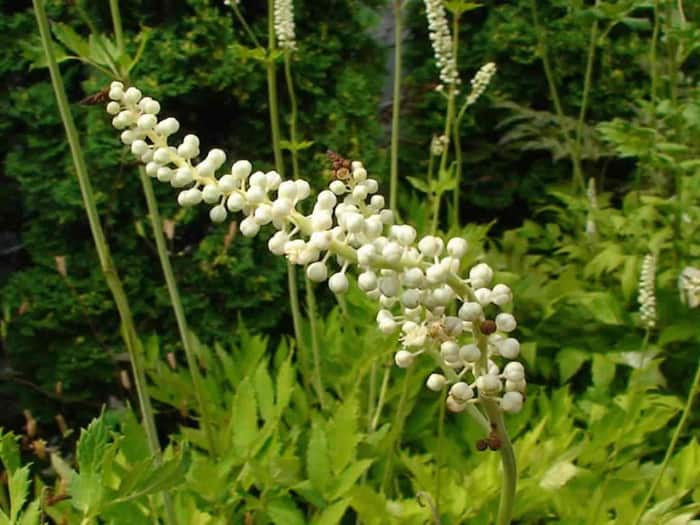
Black cohosh is a perennial herb that grows tall in summer with stalks of wispy, white flowers. Native to the woodlands of Canada and eastern United States, black cohosh has been used as a traditional Native American medicine for female reproductive problems for centuries, before becoming popularised by European settlers.
How it works
Black cohosh has been found to influence female hormones, including luteinising hormone (LH), which then reduces hot flushes and may also be able to influence oestrogen receptors.[8]
Research
A number of clinical trials have shown black cohosh to be safe and effective for the treatment of menopausal symptoms.[9]
Analysis of nine trials of perimenopausal women found an overall reduction of symptoms by 26%.[10]
A review published in the Journal of North American Menopause Society also found that when combined with St John’s wort (Hypericum perforatum) the benefits for mood and anxiety from these herbs was increased.[11]
RELATED — St John’s wort (Hypericum perforatum)
A study comparing supplementation with a black cohosh preparation and oestrogen therapy or placebo found that black cohosh was equally as effective as oestrogen in reducing symptoms.

Source: Nahaee, J. Efficacy of black cohosh (Cimicifuga racemosa L.) in treating early symptoms of menopause: a randomized clinical trial. 2013.
After 12 weeks of treatment the women taking the black cohosh preparation had a significant increase in superficial vaginal cells, which means reduced atrophy and related symptoms such as dryness.[12]
Therapeutic Dosage
Herbal tea: 2-3g dried herb infused in hot water for 5 minutes, up to three times daily.
Herb extract capsule: 40mg per day.
Liquid herb extract: 1-2ml per day (30ml per week).
Black cohosh may help balance hormone levels
Red clover
Trifolium pratense (Beebread, Clovone, Cow Clover, Daidzein)
Red clover is a perennial flowering herb that is commonly found growing in pastures around the world and belongs to the legume plant family. The little reddish, purple flowers can often be seen popping up in New Zealand grasses.
Red clover has been used in traditional medicine as a remedy for a number of health conditions, including menopause symptoms. The flower and leaf are the parts of the red clover that are most often used for their medicinal properties.
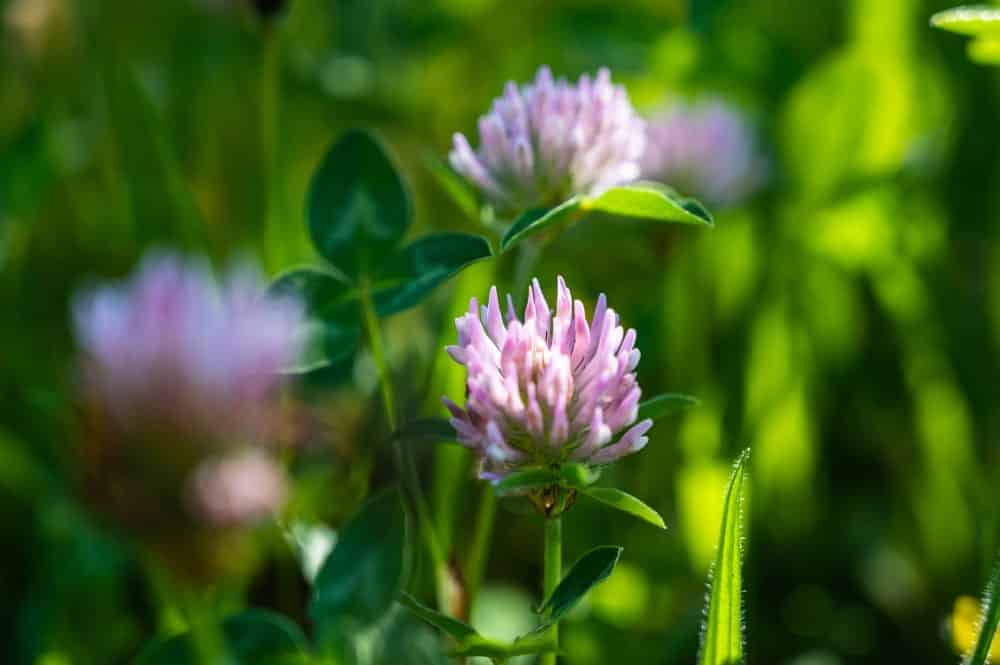
How it works
Red clover contains constituents called isoflavones, which have similar actions to the hormone oestrogen.[13] The ability to absorb and gain benefit from the isoflavones may be influenced by gut flora and diet.[14]
Research
A number of clinical studies have assessed red clover extracts and isoflavones for menopause symptoms. The largest number of studies are trials of a specific product with standardised red clover isoflavones and results show a reduction in hot flush frequency.[15]
One study combining red clover extract with a probiotic formula also found improvement in vasomotor symptoms, such as flushing and sweating after 12 weeks of treatment.[16]
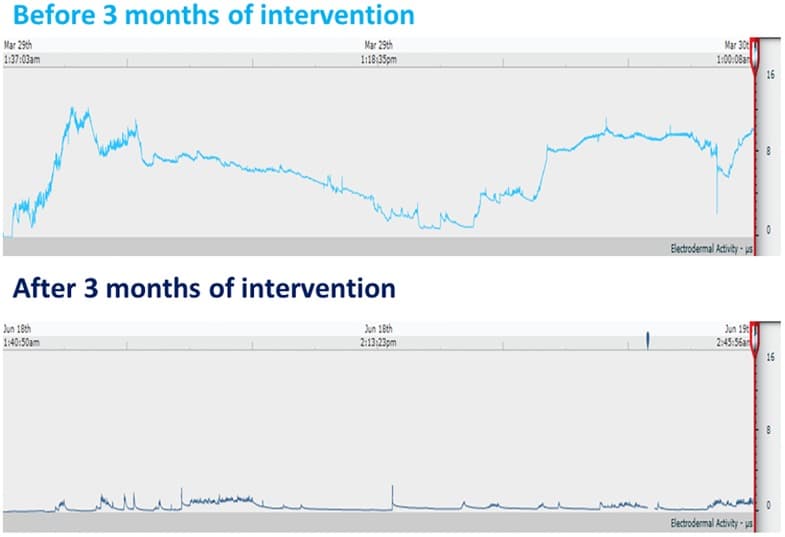
Source: Lambert, M. Combined Red Clover isoflavones and probiotics potently reduce menopausal vasomotor symptoms. 2017.
Therapeutic Dosage
Herbal tea: 2-4g dried herb infused in hot water for 5 minutes.
Herb extract capsule: 40-80mg daily of red clover isoflavones.
Liquid herb extract: 1.5-3ml per day.
Shatavari
Asparagus racemosus (Asparagus bush, wild asparagus, Inli-chedi)

Source: Kaurav, G. Shatavari (Asparagus Racemosus) – The Best Female Reproductive Tonic. 2021.
Shatavari is a type of asparagus plant that is native to Africa and Asia, but also grows in India and Northern Australia. The Shatavari plant adapts to its environment and will either grow into a shrub or climb like a vine, if support is available.
Shatavari has been used for centuries in Ayurvedic medicine as a herbal remedy known for its affinity with female health. The name Shatavari means “who possesses a hundred husbands” and is regarded as a female tonic and aphrodisiac.[17,18]
RELATED — Introduction to Ayurveda: Ancient medicinal healing methods
How it works
Shatavari contains a number of chemical constituents (isoflavones, steroidal saponins, polycyclic alkaloids) that may influence hormones.[19]
It is also proposed that Shatavari helps to reduce stress hormones, which has a positive effect on female reproductive hormone balance.[20]
RELATED — Understanding Stress: The Silent Killer
Research
The most promising results in studies are those that include Shatavari in an Ayurvedic herbal preparation. One study with 117 healthy women, aged 40–65 years using a formulated Ayurvedic medicine composed of
- 75mg Tinospora Cardifolia,
- 100mg Asparagus racemosus,
- 100mg Withania somnifera and
- 225mg Commiphora mukul per capsule,
administered as one capsule twice per day over a period of 12 weeks resulted in a significant reduction in total hot flushes, daytime hot flushes and night sweats.
At the end of 12 weeks of treatment with the herbal combination, total hot flushes were reduced by 67% and night sweats by 71%, with no major adverse reactions.[21]
Therapeutic Dosage
Liquid herb extract: 30-60ml per week split into 2-5ml doses per day.
Conclusion
Menopause is a significant and often misunderstood phase in a woman’s life, marking the end of the reproductive years and can cause a number of uncomfortable symptoms, such as hot flushes and mood swings.
Many women opt for holistic approaches, which can include diet changes, exercise, acupuncture and stress-reduction techniques like yoga. Additionally herbal remedies like black cohosh and red clover may offer some relief.
As women seek a deeper understanding of their bodies and explore these alternative solutions, they can empower themselves to embrace menopause as a natural and manageable phase of life.
Related Questions
1. My menopause might last for years – am I safe to take herbal remedies for a prolonged period of time?
Herbal remedies such as black cohosh and red clover are commonly used to support menopause and studies show they are well tolerated.
However, long term studies are limited and it is best to consult with a trained medical herbalist for an individualised prescription, before considering extended use.
It is common for herbalists to prescribe unique formulas to address individual health circumstances and symptoms and to modify the formula and dosage as needed rather than stick to one herb consistently for many years.
2. How long would I need to take natural products before I feel some noticeable relief?
Studies indicate that women begin to experience symptom relief from four to eight weeks for herbal preparations, however this may vary due to factors such as intensity of symptoms and general health status.
For yoga and acupuncture the benefits on mood and stress reduction may be more immediate, as well as building over time with regular practice.
3. Are there any warning signs of scams or safety issues with supplements?
First be wary of exaggerated claims or promises that seem too good to be true. Check for credible sources and research supporting supplement claims. Additionally watch out for products that lack clear ingredient lists or those that include undisclosed or proprietary blends.
Look for reputable brands and always consult with a healthcare professional, such as a registered naturopath before starting a new supplement regime to ensure it aligns with your individual health needs and does not pose any risk for you.
For more similar articles, we suggest browsing our Natural Medicine section.
Megan is a qualified, registered naturopath and medical herbalist based in Laingholm, Auckland. She is also a trained journalist with a bachelor’s degree in communication studies and a mother of two, with a passion for plant medicine and holistic nutrition.
A personal health journey has directed Megan to develop a specific interest in digestive and respiratory health, allergies, autoimmune conditions and children’s wellness. You can find more about Megan and her practice at Megan Rodden – Naturopath.
References
(1) Talaulikar V. Menopause transition: Physiology and symptoms. Best Pract Res Clin Obstet Gynaecol. 2022 May;81:3-7. doi: 10.1016/j.bpobgyn.2022.03.003. Epub 2022 Mar 16. PMID: 35382992.
(2) Gold EB. The timing of the age at which natural menopause occurs. Obstet Gynecol Clin North Am. 2011 Sep;38(3):425-40. doi: 10.1016/j.ogc.2011.05.002. PMID: 21961711; PMCID: PMC3285482.
(3) Caroline Smith, Heather Hancock, Jane Blake-Mortimer, Kerena Eckert. A randomised comparative trial of yoga and relaxation to reduce stress and anxiety. Complementary Therapies in Medicine. Volume 15, Issue 2, 2007, Pages 77-83, ISSN 0965-2299, https://doi.org/10.1016/j.ctim.2006.05.001
(4) Cramer H, Lauche R, Langhorst J, Dobos G. Effectiveness of yoga for menopausal symptoms: a systematic review and meta-analysis of randomised controlled trials. Evid Based Complement Alternat Med. 2012;2012:863905. doi: 10.1155/2012/863905. Epub 2012 Nov 7. PMID: 23304220; PMCID: PMC3524799.
(5) Shepherd-Banigan M, Goldstein KM, Coeytaux RR, McDuffie JR, Goode AP, Kosinski AS, Van Noord MG, Befus D, Adam S, Masilamani V, Nagi A, Williams JW Jr. Improving vasomotor symptoms; psychological symptoms; and health-related quality of life in peri- or post-menopausal women through yoga: An umbrella systematic review and meta-analysis. Complement Ther Med. 2017 Oct;34:156-164. doi: 10.1016/j.ctim.2017.08.011. Epub 2017 Aug 24. PMID: 28917368; PMCID: PMC6980280.
(6) Chattha R, Nagarathna R, Padmalatha V, Nagendra HR. Effect of yoga on cognitive functions in climacteric syndrome: a randomised control study. BJOG. 2008 Jul;115(8):991-1000. doi: 10.1111/j.1471-0528.2008.01749.x. Epub 2008 May 22. PMID: 18503578.
(7) Chiu HY, Pan CH, Shyu YK, Han BC, Tsai PS. Effects of acupuncture on menopause-related symptoms and quality of life in women in natural menopause: a meta-analysis of randomised controlled trials. Menopause. 2015 Feb;22(2):234-44. doi: 10.1097/GME.0000000000000260. PMID: 25003620.
(8) Borrelli F, Ernst E. Cimicifuga racemosa: a systematic review of its clinical efficacy. Eur J Clin Pharmacol. 2002 Jul;58(4):235-41. doi: 10.1007/s00228-002-0457-2. Epub 2002 Jun 7. PMID: 12136368.
(9) Wuttke W, Jarry H, Haunschild J, Stecher G, Schuh M, Seidlova-Wuttke D. The non-estrogenic alternative for the treatment of climacteric complaints: Black cohosh (Cimicifuga or Actaea racemosa). J Steroid Biochem Mol Biol. 2014 Jan;139:302-10. doi: 10.1016/j.jsbmb.2013.02.007. Epub 2013 Feb 28. PMID: 23459142.
(10) Shams T, Setia MS, Hemmings R, McCusker J, Sewitch M, Ciampi A. Efficacy of black cohosh-containing preparations on menopausal symptoms: a meta-analysis. Altern Ther Health Med. 2010 Jan-Feb;16(1):36-44. PMID: 20085176.
(11) Geller SE, Studee L. Botanical and dietary supplements for mood and anxiety in menopausal women. Menopause. 2007 May-Jun;14(3 Pt 1):541-9. doi: 10.1097/01.gme.0000236934.43701.c5. PMID: 17194961.
(12) Wuttke W, Gorkow C, Seidlová-Wuttke D. Effects of black cohosh (Cimicifuga racemosa) on bone turnover, vaginal mucosa, and various blood parameters in post-menopausal women: a double-blind, placebo-controlled, and conjugated estrogens-controlled study. Menopause. 2006 Mar-Apr;13(2):185-96. doi: 10.1097/01.gme.0000174470.44822.57. PMID: 16645532.
(13) Miksicek RJ. Interaction of naturally occurring non-steroidal estrogens with expressed recombinant human estrogen receptor. J Steroid Biochem Mol Biol. 1994 Jun;49(2-3):153-60. doi: 10.1016/0960-0760(94)90005-1. PMID: 8031711.
(14) Rowland I, Faughnan M, Hoey L, Wähälä K, Williamson G, Cassidy A. Bioavailability of phyto-oestrogens. Br J Nutr. 2003 Jun;89 Suppl 1:S45-58. doi: 10.1079/BJN2002796. PMID: 12725656.
(15) Myers SP, Vigar V. Effects of a standardised extract of Trifolium pratense (Promensil) at a dosage of 80mg in the treatment of menopausal hot flushes: A systematic review and meta-analysis. Phytomedicine. 2017 Jan 15;24:141-147. doi: 10.1016/j.phymed.2016.12.003. Epub 2016 Dec 12. PMID: 28160855.
(16) Lambert MNT, Thorup AC, Hansen ESS, Jeppesen PB. Combined Red Clover isoflavones and probiotics potently reduce menopausal vasomotor symptoms. PLoS One. 2017 Jun 7;12(6):e0176590. doi: 10.1371/journal.pone.0176590. PMID: 28591133; PMCID: PMC5462345.
(17) Singh R. Asparagus racemosus: a review on its phytochemical and therapeutic potential. Nat Prod Res. 2016 Sep;30(17):1896-908. doi: 10.1080/14786419.2015.1092148. Epub 2015 Oct 13. PMID: 26463825.
(18) Sharma et. al. 2000. Asparagus racemosus (Shatavari): A Versatile Female Tonic. https://citeseerx.ist.psu.edu/document?repid=rep1&type=pdf&doi=25fce2caf8d5164f7ea15e1b440dc79ff2e7f599
(19) Alok S, Jain SK, Verma A, Kumar M, Mahor A, Sabharwal M. Plant profile, phytochemistry and pharmacology of Asparagus racemosus (Shatavari): A review. Asian Pac J Trop Dis. 2013 Jun;3(3):242–51. doi: 10.1016/S2222-1808(13)60049-3. PMCID: PMC4027291.
(20) Pandey AK, Gupta A, Tiwari M, Prasad S, Pandey AN, Yadav PK, Sharma A, Sahu K, Asrafuzzaman S, Vengayil DT, Shrivastav TG, Chaube SK. Impact of stress on female reproductive health disorders: Possible beneficial effects of shatavari (Asparagus racemosus). Biomed Pharmacother. 2018 Jul;103:46-49. doi: 10.1016/j.biopha.2018.04.003. Epub 2018 Apr 7. PMID: 29635127.
(21) E. Steels, M. Steele, M. Harold, L. Adams, S. Coulson, A double-blind, randomised, placebo-controlled trial evaluating safety and efficacy of an ayurvedic botanical formulation in reducing menopausal symptoms in otherwise healthy women. Journal of Herbal Medicine. Volume 11, 2018, Pages 30-35, ISSN 2210-8033.https://doi.org/10.1016/j.hermed.2018.01.001.



